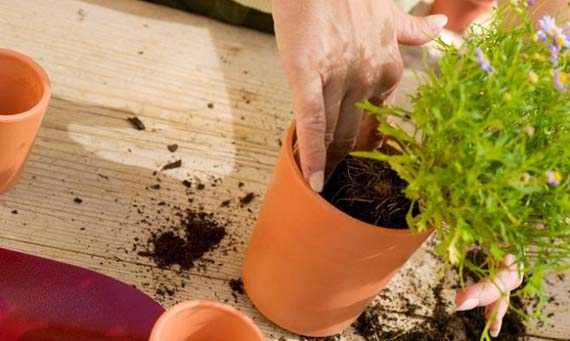
We were recently talking about characteristics of a good substrate for growing vegetables in pot. As we are in a time of changes in the flowerpot, we are going to see the different types of substrate that we can use for our new autumn crops.
As we grow in pots, we must enrich your soil, since it is scarce and soon our plants absorb its nutrients. We can fill our pots with two basic mixtures: 50% substrate and 50% compost or 70% substrate and 30% worm castings. But what types of substrate are there on the market and which is the most suitable for our pots?
For the land to be fertile it must be porous. This axiom is fundamental for the choice of the substrate.
A good substrate must be light, porous, nutritious and stable.
The roots have to be able to develop easily. If the soil is compact and does not have enough air pockets, the plant will develop fewer roots, therefore, it will absorb less water and fewer nutrients.
On the other hand, organic soils are alive and the small microorganisms that live in them need oxygen to live. With a compact or waterlogged substrate, these organisms, which are very beneficial for plant growth, begin to die.
If we achieve this balance of porous soil and moisture, we will not need to add any chemical fertilizers to our vegetables.
It is important to read the components of the substrate that we are buying. The most typical universal soil and substrate preparations sold on the market contain the following elements:
- Peat: Partially decomposed remains of the "Sphagnum" moss and constitutes the main component of most universal substrates.
- Sedge fiber: Ancient, partially decomposed remains of sedge, stems, and grasses.
- Coconut fiber: Composed basically of recycled coconut bark.
- Vermiculite: Made from micaceous rock heated to 1100ºC. It has a golden foil look and is very light.
- Perlite: Made from volcanic rock, crushed, sieved and raised to a temperature of 980ºC. It has the appearance of small light white balls.
- Limestone elements: They constitute a source of calcium that is usually added to peat to counteract its acidic pH.
Well, the substrate that we buy must have peat, perlite and limestone elements. It would also be convenient if the mixture does not incorporate it (as it usually happens in most brands) to add a scoop of vermiculite. We must avoid coconut or sedge fiber because they absorb a lot of water and in the case of pots, the earth can become flooded.
We will know that the mix we have bought is of good quality because the soil will have a loose appearance and will contain pearlite. If the soil contains many stems and wood chips, the quality is inferior.
Before buying the soil, you have to take a good look at the composition because there are cheaper bags due to the low content of perlite and / or vermiculite (which are more expensive than peat) and both are the most important element to give air to the substrate.
More information - the substrate
Source: urbanicultor.es
Your post on earth is great for me because I was about to fix all the pots on my terrace and I didn't know where to start. I take good note. I'll tell you.
Great, Anamaper. I love that it serves you. It is time to make arrangements, right? Don't miss out on taking advantage of the land: http://www.jardineriaon.com/aprovechar-la-tierra.html I hope it is useful to you too. A kiss!
Hello, I have a 1.70 meter cube-shaped cement pond. x 1.20 mts. x 1.10 mts. I want to use it as a small garden, as I prepare the ground, as I condition the layers of substrate, or what I use to prepare it. if you could answer me begazoraa@gmail.comThanks Marco
For the first time I have made a garden in pots and I bought four bags of one soil in a supermarket, right there I bought five large pots. I filled them and planted them, when I wanted to add other plants on the sides, I realized that it was so compact that it seemed like it had a cement mixture. I did not enter sticks. And it cost me dearly. In the bag it said nothing, to add something else. How do I fix it?
Hi carmen.
Ugh, calm down. What you say has happened to many of us.
The land they sell in supermarkets and hypermarkets is usually not good for plants. You can improve by mixing it with perlite in equal parts, which are sold in nurseries as well as in online stores (such as here for example).
If you have a construction products store nearby, a very good alternative to perlite, and very cheap (the 25kg bag does not reach 2 euros), is the construction sand (gravel) of small grain (2-3mm of thickness). Also, if it is used, it must be mixed with the soil at 50%.
Greetings.